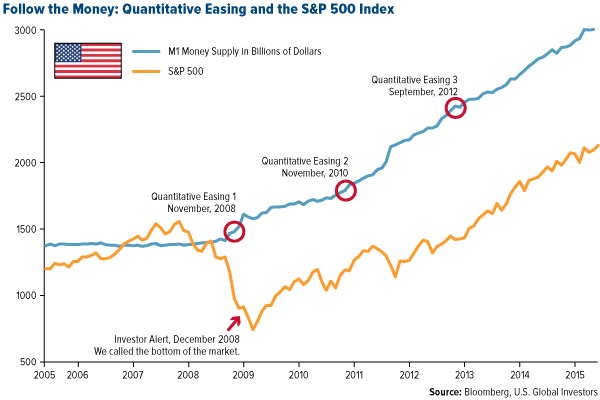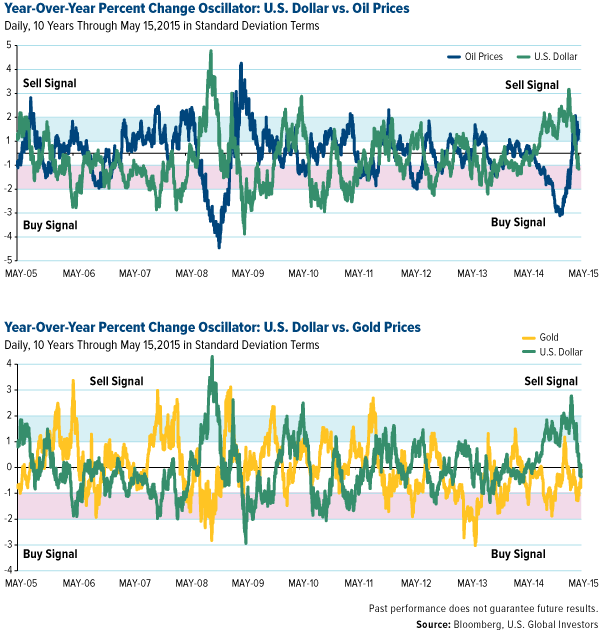We’re only halfway through the month, but so far the old trading adage “Sell in May and go away” seems a little premature.
Last Thursday, the S&P 500 Index closed at new consecutive record highs, topping the previous record set on April 24 and further extending the six-year bull run. The surge came on the heels of weaker economic data last week, leading investors to believe that the Federal Reserve will refrain from raising interest rates this summer, if not this year.
All 10 sectors ended Thursday’s session in the black, with technology leading the rally. Apple, held in both our All American Equity Fund (GBTFX) and Holmes Macro Trends Fund (MEGAX) , and Facebook, held in MEGAX, made the widest gains.
Friday’s close came within just a few points of another new high, suggesting that a top has not yet been reached but that instead the market is looking to break out.

Dividend Growth at 15 Percent
With a little over 90 percent of S&P 500 companies having reported, average first-quarter earnings for the index rose a modest 2 percent. That might not seem significant, but as LP Financial’s Chief Investment Officer Burt White points out in a recent Barron’s piece, “given the steep uphill climb that corporate America faced due to the twin drags of the oil downturn and strong U.S. dollar, this is actually a good result.”
Indeed, when the earnings season began, economists were expecting to see a 3-percent drop because of depressed oil and the strong dollar. Of course, we’re now seeing a price reversal in both the commodity and currency.
Dividends from S&P 500 companies also rose, jumping about 15 percent in the first quarter, defying lackluster estimates. Delta Air Lines, also in MEGAX, announced this week that it would be raising its dividend 50 percent as well as buying back $5 billion in stock over the next couple of years.
What’s important for investors to recognize here is that the S&P 500 dividend yield is currently at 1.92 percent, ahead of the 1.50-percent yield on a 5-year government bond. And unlike the government bonds, equities give you potential growth. It’s these high dividend-paying companies that GBTFX and MEGAX seek to invest in.
Investors Shrug Off Weak Economic News
The week’s economic data suggests that the U.S. economy is growing at a slower rate now than in previous months.
According to the U.S. Census Bureau, retail and food service sales in April were little changed from March. Inventories are steadily creeping up.
On Friday, economists trimmed their forecast for the rate of jobs growth this year from 3.2 percent to 2.4 percent. Meanwhile, the University of Michigan consumer confidence index fell pretty dramatically from 95.9 in April to 88.6 in May.
This soft economic news appears not to have dampened investors’ spirits too much, however, as it means the Fed will be more likely to keep rates low for at least the short-term.
You can see that the M1 money supply, the most liquid form of capital, began to ramp up with the first round of quantitative easing (QE) in late 2008, pulling the S&P 500 up with it. We called the bottom of the market in an Investor Alert from December 2008.
After three cycles, QE officially wrapped up last October, but money continues to flow into the market, lifting all boats.
Lately, investors have been moving more of their money out of domestic equity funds and into internationally-focused funds, especially those focused on Europe, according to a Credit Suisse report. This is in line with the results of a Bloomberg survey I shared earlier in the month which shows that global investors are most bullish on the eurozone than any other region, a good sign for our Emerging Europe Fund (EUROX) .
Significant Inverse Relationship Between the U.S. Dollar and Gold/Oil
The U.S. dollar lost more ground for the fifth straight week, falling to its lowest level since January. This has allowed crude oil to begin its recovery—it’s currently trading just below $60 per barrel—while gold marks time in the $1,200 range.
As you can see, the dollar reverted back to its mean after rising to close to three standard deviations as recently as mid-March. There’s plenty of momentum for the dollar to drop even further, which should help oil’s recovery.
Gold remains in a three-year bear market. In an interview with Jim Puplava on the Financial Sense Newshour , I explained that the domestic equity bull market has lately overshadowed the yellow metal as an asset class, but that when gold’s down, as it is now, it might be time to put money in gold and gold stocks.
This week we expect to see preliminary purchasing manager’s index (PMI) numbers for not only the U.S. and Europe but also China. Perhaps we'll see if the U.S. economy has really softened or if it’s simply taking a breather after months of steady growth.
Happy investing!





